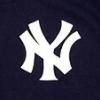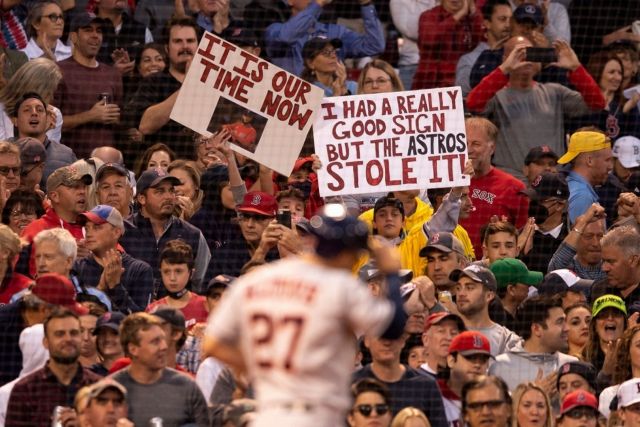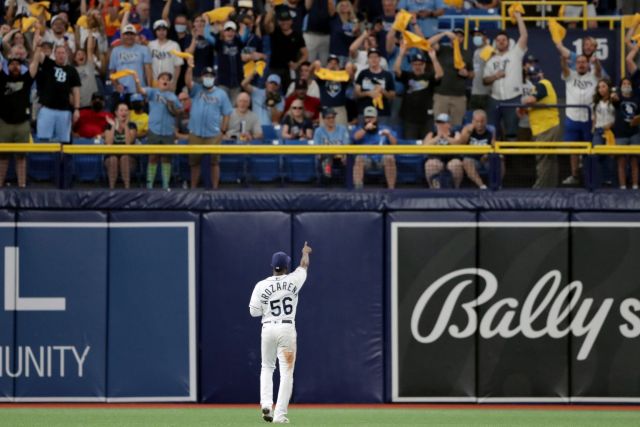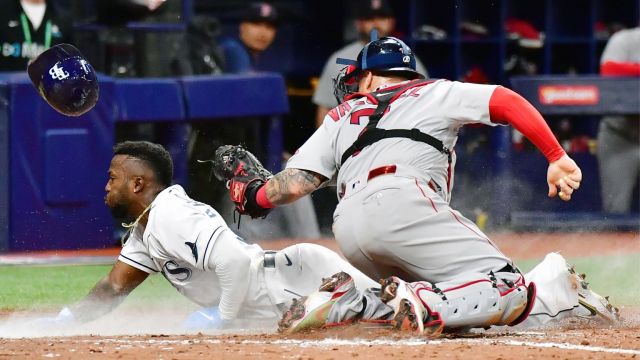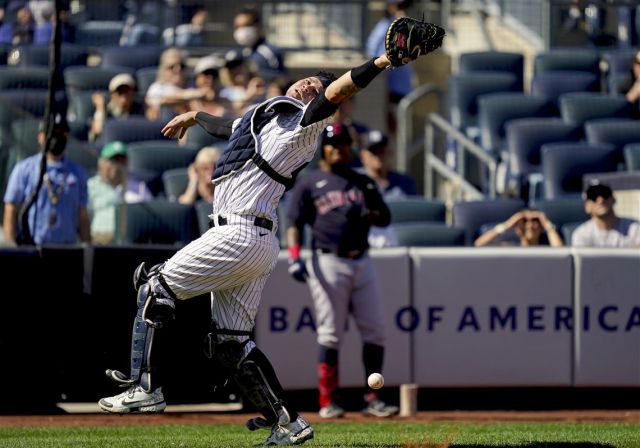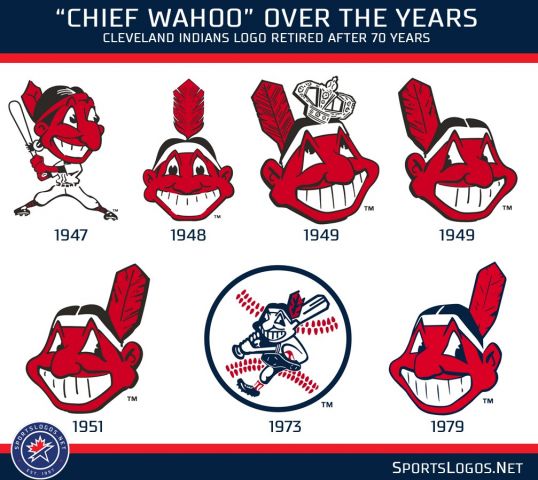-
Posts
26980 -
Joined
-
Days Won
82
Content Type
Profiles
Forums
Downloads
Everything posted by Yankee4Life
-
Oh!!! So that means they played like the Yankees? 😀
-
Exactly what I was thinking. Red Sox fans, at least nine out of ten of them will rub it in your face when their team wins. I wasn't comfortable rooting for Houston but it was damn better than rooting for Boston. Here's a big reason why I don't have time for the average Red Sox fan. Back in 2004 when they won their first World Series in eighty-six years we had new users join up here on the site with Red Sox user names such as Manny24, Pedro, Papi, etc, etc and all of them claimed to be "lifelong" Red Sox fans. Yeah, sure they were. Bandwagon fans, yes. Lifelong? Not a chance. Maybe fans from the last few months of the season but that's about it. Believe it or not I have talked to many pretty good Red Sox fans in here. Boston has had an insane amount of luck for a long time now with their major sports teams and I am just patiently waiting for it to end.
-
I'm glad you liked them. I consider it a treasury of baseball history. If you have not already listened to it I recommend Game six of the 1936 World Series. The Yankees scored seven runs in the ninth to win the series. Joe Dimaggio, Bill Dickey, Lou Gehrig, Tony Lazzeri and Lefty Gomez are playing for the Yankees and Bill Terry, Mel Ott and Gus Mancuso are playing for the Giants. This is when baseball was baseball.
-
Oh, don't get me wrong. It doesn't bother me at all that they are gone. They got to start somewhere and I am just curious to see what players will go too. I think it is also a panic move. But they have to start somewhere.
-
Phil Nevin and Marcus Thames were let go by the Yankees. Like that is supposed to fix everything.
-
I waited a few days to post this because to be honest I have been catching up on my sleep. Whatever day it was that the Yankees lost in Boston it doesn't matter now but since that loss I have been sleeping very well because finally the final chapter in this terrible 2021 season is done. Don't misunderstand at all and just take this for what it's worth. I did not want them to lose the wildcard game and especially to that particular team but at the same time I expected them to lose because all you have to do was watch them play all year and you knew something was going to go wrong. I don't know what happened with the success of 2019 and how it morphed into a lazy and one-dimensional team that they are at the present time. This is a ballclub that from top to bottom is a lousy hitting team. And you might say to yourself but they have such good hitters and that's true but they all try for the homerun every single time they are at bat and good pitchers are always able to take advantage of it. If you are looking for a team that can't hit, strikes out way too much, makes too many errors and does not know how to run the bases then look no further because these guys are just for you. And now we head in to another off-season that is going to be built on excuses and promises. Nobody and I mean nobody looks at the Yankees like the Yankees anymore. No one is afraid of them and teams like Tampa Bay lick their chops when they have to play the Yankees. Get your head around the sad fact that the Kansas City Royals have been to the World Series two times since the Yankees in 2009. Kansas City! The only people that live there are the ones that have to. Many changes need to be made. Okay, no kidding. But where to start? Behind the plate is as good as any. If the Yankees decide that watching Gary Sanchez for a 162 game season is worth bringing back for another year that I am first going to cancel my MLB account and stop watching them altogether because this guy has worn out all his chances. I don't wish for anything bad to happen to Sanchez but if he ends up getting on the wrong plane that lands in North Korea instead of the Dominican Republic I would care less. Luke Voit? If they don't sign Anthony Rizzo than this guy can get lost. He gets hurt too much. And before they give Gleyber Torres a new contract they should see if he has a pulse first. Brett Gardner has to go. The guy did nothing but so did so many others. Clint Frazier? What the hell? He gets handed the left-field job and then he handed it right back to them. Pitchers? Big deal that they got rid of Andrew Heaney. Even the school of the blind saw that coming. I don't expect them to contend next year because they have too many issues and I think Aaron Boone is part of the problem too but if he comes back that is anyone's guess. Spring training is only a few short months away. We get through this winter and there it is. So, that is something I look forward to. But the first time you hear any Yankee say that they have a "championship ballclub" you should laugh in his face because he is flat out lying to you.
-
Me too. Tampa hits and runs, mixes and matches well, doesn't always go for the home run all the time, etc. In other words what a winning team does.
-
Well I think I made a link to the wrong article. My fault entirely. I did write it past midnight so that's the only excuse I have. Also it is not worth it for me to look for the correct one right now because it's over and done with. Yes it was a playful one and it also had zero to do with the game and more to do with the city. Those are the kind of articles that when you read them they make you laugh a little but then you quickly forget about them. Sorry I responded so late. My internet was down. No I don't. And the only one with a hard on around here is you with anything I post about. You'll do anything to get under my skin because that's the kind of person you are. Tatis is not the new Bryce Harper because I actually want him to succeed. I want Harper to fail and fail miserably. I want Philadelphia to never experience a winner as long as he is on the team and I will never root for him. If you take that personally, that's wonderful. It wasn't meant that way but go ahead make it all about yourself. I say something about Harper and you take it personal. I want to see the Padres win out in the NL West and for Tatis to do well. But I won't turn a blind eye and not notice that he is a hot dog and a showoff who seems to think he is bigger than the game. Still got that hard on? Good. I think I am allowed to talk about baseball without running what I want to type past you. What would be a shock is if you mind your own business and stop trying to bait me. I can only ask this as nice as possible. I don't need or want this back-and-forth with you. You don't seem to mind it but I do. Do NOT reply in here. This is done. ................................................................................................................................................................................................................................................................. I reluctantly have to admire Tampa and am hoping they can win two more games in a hurry. Game one hero. A steal of home!!
-
Well, me neither but the fact that these idiots are out there and they enjoy this. They'd be the first to raise hell if you ragged on them.
-
Hey folks, gather around. Real baseball talk here. Surprising no one the Padres fired manager Jayce Tingler. A team that was expected to compete for the N.L. West title ended up four games under .500 in 2021 but at least their shortstop lead the league in poses and pointing up to the sky which should amount to something. The Yankees face tough decisions in the off season. In other words, who to blame and who goes? As usual Boston knows how to rub it in. How does Tampa keep doing it? Here's a hint. They watch what the Yankees do and then do the opposite..
-
As soon as they are eliminated the trolls come out.
-
J.D. Martinez out for the playoff game tonight.
-
Not bad, not bad at all. And there are some people in here that think we are the only ones who can't stand Sanchez. A lot of the Yankee fan base hates him and for good reason. More good news. The Yankees designated Andrew Heaney and Brody Koerner for assignment and Greg Allen and Rob Brantly were added to the Yankees roster for Tuesday’s AL wild-card game against the Red Sox at Fenway Park.
-
No, YOU don't care. And that does not bother me at all because I just consider the source. I used that Republican analogy because it's true. Massachusetts is a democratic state and they've always been. I didn't use that example as a poke at you for any reason because you're not worth my time as I have better things to do. Jim that was no dig at the people of Massachusetts. I know I may sound at times like I can not stand the entire state but in truth it is only the Red Sox fans at Fenway Park. I recall the last time in the early 90's when I was there on a bus excursion that I wore my Yankee hat to restaurants and around town after the game and not one person bothered me. And by the way you should be proud you are one of "them." Of course. You could not resist. That's because that's how you are. Don't respond in here unless it has to do with baseball and the subject of baseball. This little back-and-forth is done right now.
-
There's more of a chance to see a Republican in Massachusetts than there is an alligator but if you look closely you will see that the name "Gator" is an acceptable name for a sports team because what the hell are you going to do, ask one of them if they mind? The San Diego Padres need to get their heads out of the clouds and address the selfishness of Tatis, Jr. The guy is simply in love with himself. Changing the name? No. Changing their attitudes? Yes. And if they want to change the name then each and every father who has lived in San Diego now or at any time should be consulted if they want the name change and if <gasp> they require counseling because the team is called the Padres.
-
The average time of a nine-inning game was 3 hours, 10 minutes, 7 seconds for the 2021 regular season. That probably does not count Red Sox games, which take a lot more to finish. The Padres (79 - 83) have probably cost their manager his job and that's too bad. Tatis was so busy posing and bringing attention to himself. He needs to mature fast. Don't count on it though. I won't underestimate the Cardinals when they have to go up against the Dodgers, who won 106 games. The only reason why the Phillies ended up in second place is that they are in the worst division in baseball. Go home Ohtani. Same for you fat Vlad. You act like Tatis but it is easy to tell you both apart since you have 150 pounds on him. Baseball talk. How's that?
-
Can someone go back and look at the great play made by Gio Urshela yesterday? The link is right here. Watch at the beginning of the video but don't look at Urshela. Watch Sanchez and watch how he was just being his usual self by just loafing after the ball. Can anyone else see this?
-
You guys are both right.
-
This afternoon in Texas will be the last game the Cleveland Indians will ever play and the way I see it that is a damned shame. So, thank you to all of you on twitter who cried, moaned and complained about this. How about trying to support something that really makes a difference in the world instead of the name of a baseball team? Naturally anyone who is sad to lose the Indians name and logo suffers from feeling immediately being labeled a racist. I'm not. I'm not even an Indians fan but I am a baseball fan who respects the traditions of the game. That is something that seems to be in the minority now. They may take the name off of the ballpark and on the field and on the uniforms but that team Cleveland will always be known as The Tribe.
-
The 2021 version of the Yankees have made me care less about this team and baseball.
-
Harper had nothing to apologize for. Not a damn thing. Now if you want apologies, look to a certain New York team. This is a forum. People are allowed to post.
-
To be fair no one on the Yankees hit yesterday so Stanton should not be singled out. Those losers only got four hits in the game while Tampa had nineteen. But there is no excuse for Torres. and certainly none for Sanchez. Sanchez went 0-for-3 with a walk, including a strikeout and a game-ending double play, to extend his slump to 6-for-31. This guy is nothing but has been piece of crap.
-
Yeah sure he did. He is entering the last game of the season hitting .308 with 35 home runs and 84 runs batted in. What does he have to apologize for? Harper had a great season but the rest of the team didn't. But this got him more attention so that is probably what he wanted. He has nothing to apologize for because any team would take those numbers for one of their starting outfielders.



